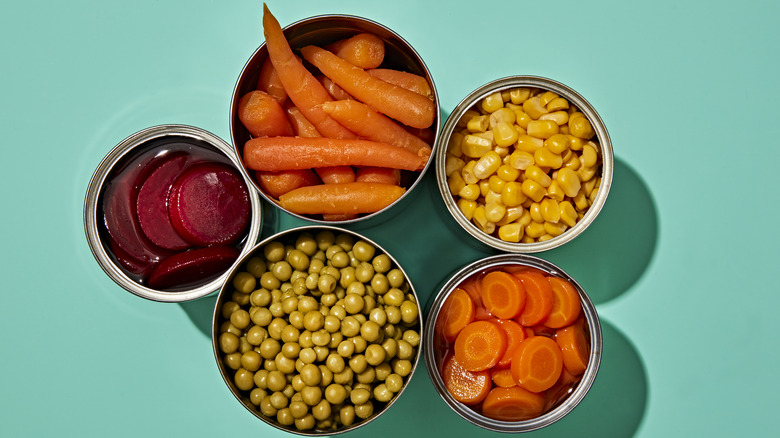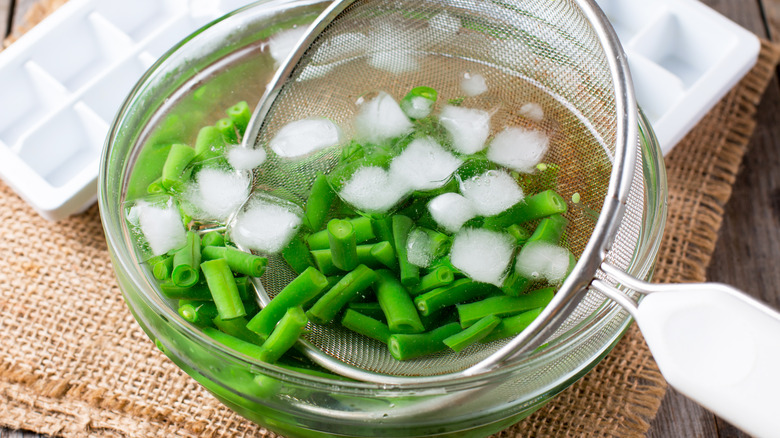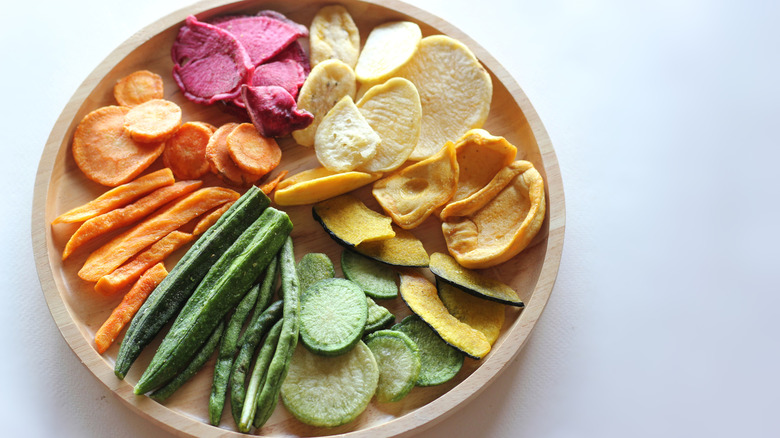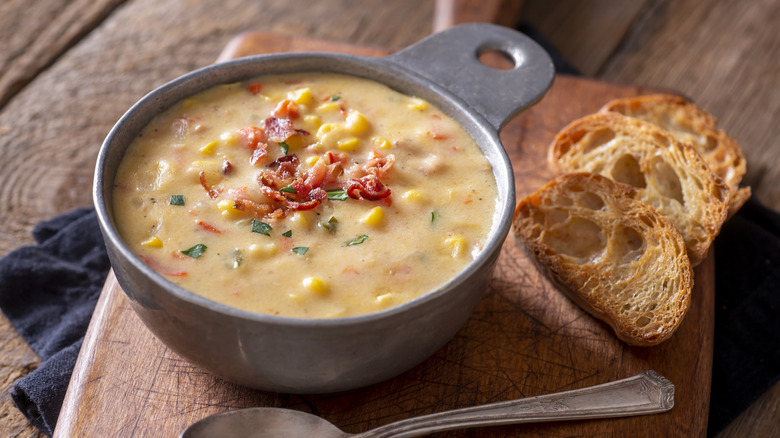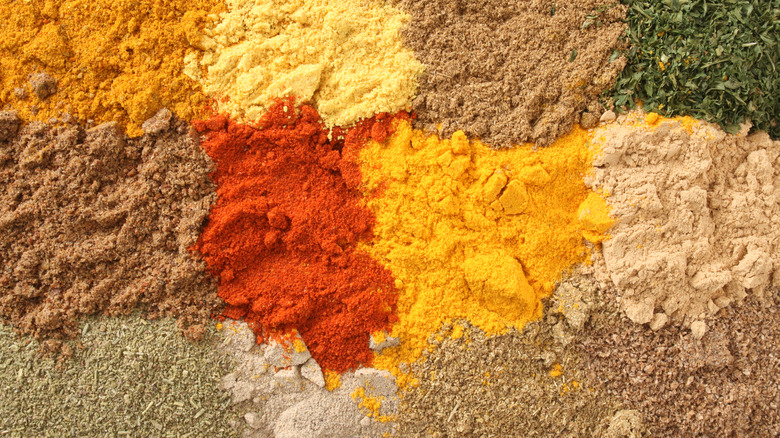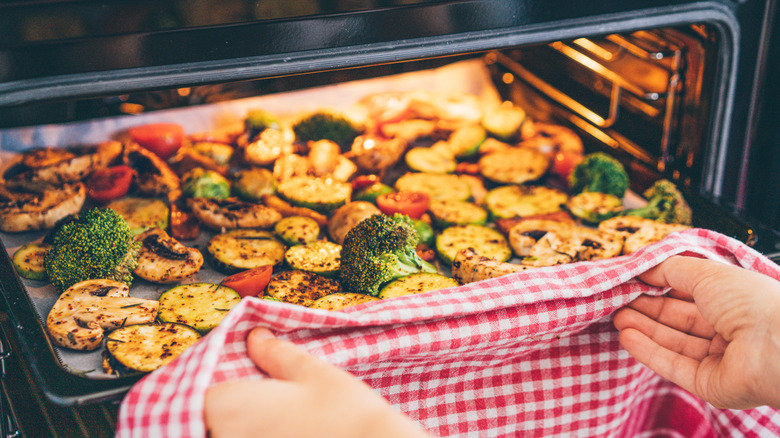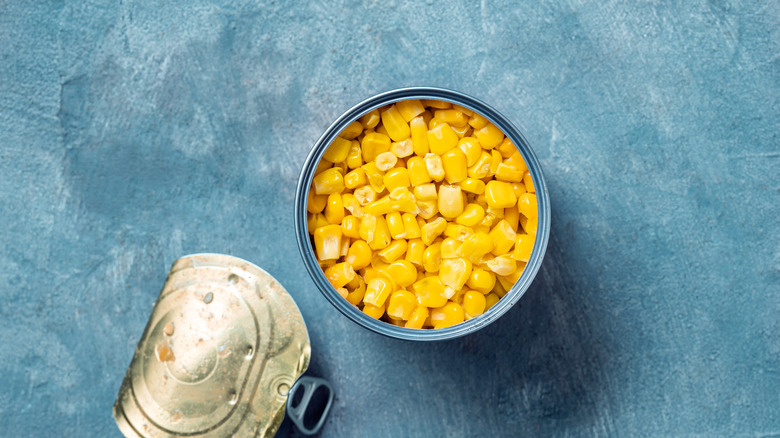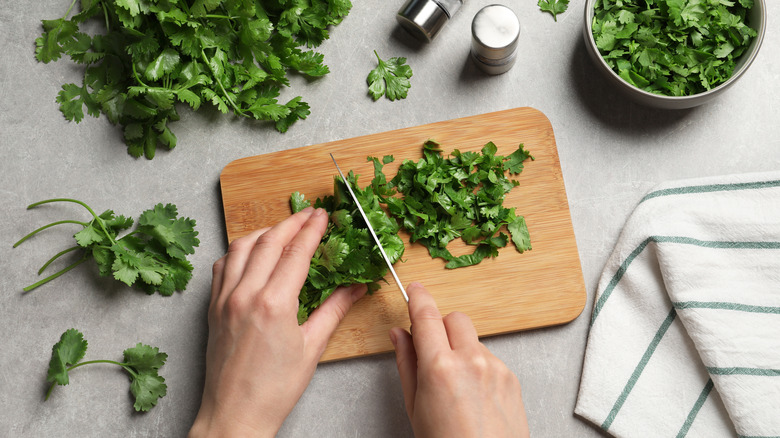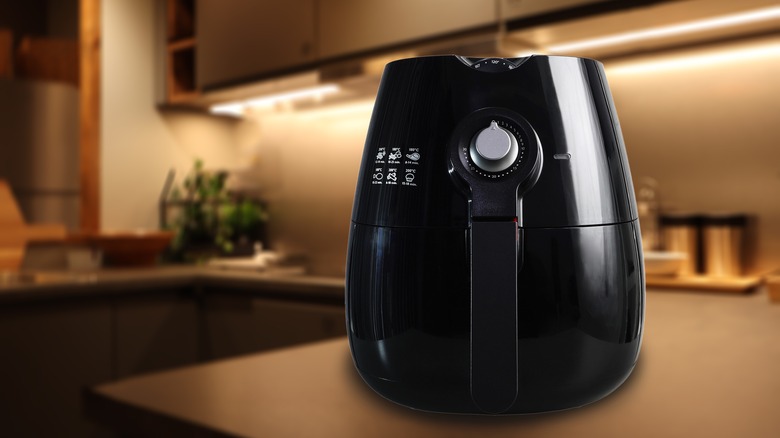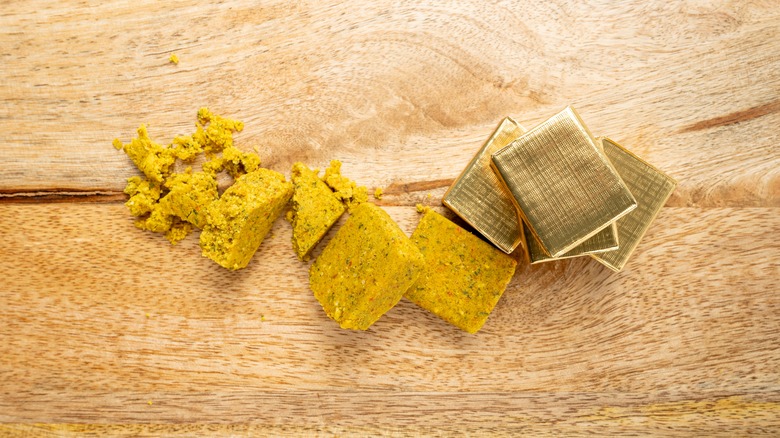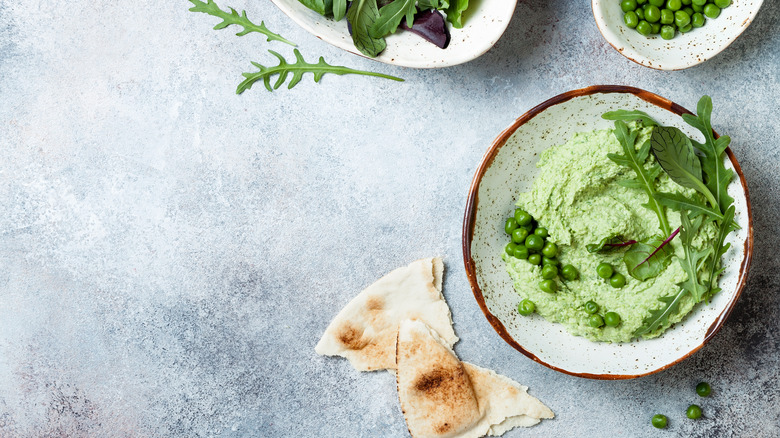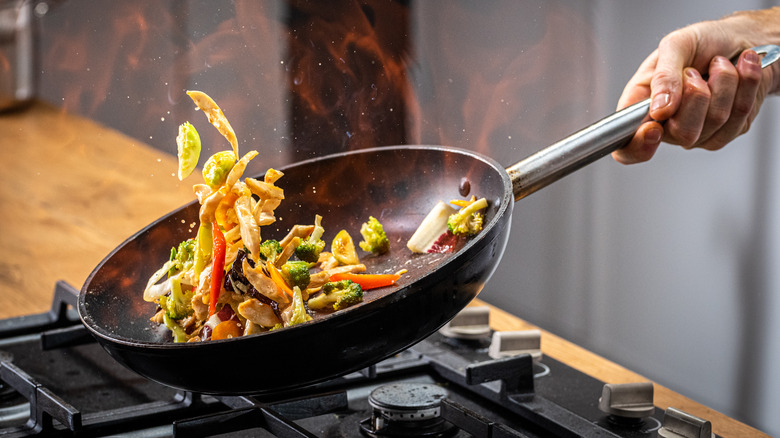14 Simple Ways To Make Canned Vegetables Taste So Much Better
Canned vegetables are a gift to any time-pressed cook. Instead of having to mess around with washing, chopping, and cooking your veggies, you can just pop open a tin and they're ready to go. As these food products stay fresh for years, you don't even have to worry about them going bad. One thing you do need to worry about, though, is taste. Canned vegetables have a reputation for being bland, vaguely metallic, and limp, and if you're not careful they can drag down your meal. Thankfully, these veggies are as easy to upgrade as they are to prepare, and using the simplest of ingredients and methods you can quickly amp up your side dish.
While canned vegetables are already cooked and ready to eat, giving them a further blast of heat can make them even tastier. Blanching, roasting, or air-frying your canned vegetables can unlock new textures and flavors, and almost make them taste fresh. Canned vegetables are also as easy to season or flavor as their fresh siblings, and by dousing them with fats, herbs, or seasoning mixes you can give them a new lease of life. Most of these upgrades take barely any time, either.
1. Blanch your canned vegetables to freshen them up
There's no getting around it: Canned vegetables can often taste like metal. While this isn't always the case, some varieties can absorb the metallic tones of their containers, leaving you with an ingredient that tastes like sucking pennies. However, if you want to get rid of the canned taste in your canned veggies, all you need to do is blanch them. A quick submersion in boiling hot water can rid your vegetables of any metal flavor notes, warms them up so that they're ready to eat, and also removes any excess sodium.
To blanch your canned vegetables, you'll need to move quickly. It's important to remember that canned veggies are already cooked, so don't want them to spend too long in the hot water — if they do, they'll just become incredibly mushy. Once you drain them from their can, rinse them with some cold water to get rid of any extra saltiness. Then, pop them into a pot of boiling water for a minute or so. Once they've had a chance to boil, drain them into a bowl of ice water. Alternatively, if you're planning on serving them straight away, allow them to steam dry and then pop them onto your plate.
2. Hit them with a little lemon juice
The best improvements are often the ones that are simplest to execute. When it comes to canned vegetables, a big mistake you're making is forgetting that a quick squeeze of lemon juice can improve their flavor enormously. Adding acidity to canned vegetables has two key effects on them: It can add some all-important brightness to your vegetables, while simultaneously reducing their metallic notes.
It's best to add lemon juice just before you're planning on serving your veggies by simply squeezing it over the top. If you don't have any lemons, lime juice is the perfect substitute, bringing that citrusy intensity without being too briny. Light vinegars like rice or white wine vinegar can have a similar effect without imposing too much flavor on the vegetables. While balsamic, red wine, and aged vinegars can also add brightness and can help to successfully mask any metallic notes, they also introduce a lot of extra flavor. If you're using them, make sure that they fit into the overall taste of your dish, or serve your vinegar-coated veggies as a standalone side.
3. Dehydrate them to make a quick snack
Canned vegetables tend to be used in a few key ways: If you aren't tipping them into a stew or a soup, you're popping them onto your plate as a side dish. What fewer people do, however, is dehydrate them — but once you've done this, you'll never turn back. Dehydrating canned veggies to serve as a snack is one of our favorite ways to upgrade them, and you don't even need a dehydrator to do it. You can simply lay out your drained, dried vegetables on a baking sheet lined with some parchment paper, and put them in the oven on a low heat for a few hours.
Having said this, if you're planning on regularly dehydrating vegetables, it's a good idea to invest in a dehydrator. You can find cheaper models relatively easily, and they work far more efficiently than ovens do to dehydrate foods. Because canned vegetables are often pretty salty, you don't even need to add much flavor to them for them to be tasty. If you want to hit them with some extra herbs and spices to amp them up, though, be our guest.
4. Turn them into a chowder
Canned vegetables are a delightfully flexible ingredient, but it's hard to get past their texture. Even the best-quality canned veggies have a somewhat soft texture. Although there are ways to firm them up (like roasting them), we'd encourage you to go in the other direction, blending them to turn them into delicious chowder. This allows you to have all the nutrition and flavor your canned vegetables provide while repurposing them effectively.
To make chowder out of canned vegetables, grab your blender and a few choice ingredients. Pop your veggies into the blender and add a hearty splash of milk or cream to bulk them out before whizzing them together. Canned corn is arguably the best base for a chowder, but you can also experiment with other canned vegetables like carrots or potatoes. Once you have your base, you can then add in any canned vegetables you like (or want to use up), and they'll be enveloped in the creamy, filling liquid. Canned peas, carrots, and green beans all make great ingredients for a canned vegetable chowder. Don't forget to add your favorite proteins, too.
5. Add some spices
Vegetables work particularly well with spices, and canned vegetables are no different. By adding your favorite spices to them, you can completely transform your canned goods into an aromatic, piquant side dish. They're also a great way of aligning your canned vegetables with whatever dish you're serving them with. If you're whipping up a Tex-Mex feast, make a side of spiced canned corn and beans, spiking them with cumin, paprika, and cayenne pepper. If you're serving a biryani, mix some canned vegetables with garam masala.
If you're adding spices, you can use both whole and ground versions. Just bear in mind that whole spices will need a little cooking beforehand to wake up their flavors and prevent them being too harsh. Unless they're already cooked, ground spices benefit from a quick blast of heat too. Sizzle them in a frying pan with some hot oil before pouring the combo over your canned vegetables for immediate flavor. Oh, and don't forget to add a sprinkle of salt to tie everything together.
6. Sauté them in some butter
What's better than butter? In our opinion, nothing — especially when it comes to canned vegetables. Sautéeing canned vegetables in butter is one of the quickest ways to add immediate flavor to them and make them taste luscious and rich. The smoothness of butter enlivens even the mushiest of canned vegetables, highlighting their natural taste notes and adding in loads of creamy flavors. You don't even need to whip out a pan to add it, either. If you're feeling lazy, just decant your canned vegetables into a microwaveable bowl, pop a pat of butter on top, and heat them together until it's melted. Stir, serve, and enjoy.
If your canned vegetables have been packed in brine, it's usually a good idea to go for unsalted butter, otherwise, you risk of the dish being too salty. Don't feel that butter's the only fat you can add, either. Coconut oil, margarine, and even vegetable oil can also give the vegetables loads of richness. If you want to transform your veg even further, you can douse them with a flavored oil. Just don't heat this type of oil up too much, as you'll reduce its flavor.
7. Roast your canned vegetables
Just because your canned vegetables are good to go straight out of the can, doesn't mean you have to eat them that way. Roasting them is an incredible way to introduce enormous extra flavor to your vegetables, while also developing their texture. This method is loved by everyone's favorite home cook Tabitha Brown, who demonstrates over on Instagram how she makes her veggies.
The best thing about roasting canned vegetables is that not only is it a great way to get through your old canned produce, but you can throw virtually any kind into the oven. Brown proves this point by roasting canned garbanzo beans, hearts of palm, and mushrooms together, sprinkling on her favorite seasonings and cooking until golden brown. As the vegetables cook, their exteriors gently crisp up (which is helped by any dry seasonings you've added, and any fat too), while the interiors stay moist. Once they're ready, you can pile them over rice as Brown does, serve them with grilled or barbecued meat, or just eat them straight out of a bowl.
8. Turn canned corn into a crispy snack
Corn is one of the most reliable canned vegetables out there. Canned corn somehow manages to avoid the mushy texture that plagues other canned vegetables, and for the most part it's reliably juicy and taut, holding its own in any dish you add it to. One thing you likely don't expect your corn to be able to do, though, is to be crispy — and we're talking chip-level crispy here, guys. However, the truth is that making crispy canned corn is super easy, and takes just a few ingredients.
The trick is to coat your canned corn in a combination of cornstarch and rice flour before frying it in a generous amount of oil until it's golden-brown on each side. Using this combo of starch and flour develops a light, crispy exterior that's reminiscent of tempura. You should also add a dash of water to turn them into a thick paste to ensure that each piece of corn is fully coated. As for how to flavor your corn, the possibilities are endless. You can add sugar and salt to make it sweet and salty, mix in some spices to make a fiery snack, or sprinkle some nutritional yeast on at the end for a cheesy flavor.
9. Hit them with some fresh herbs
Making canned vegetables taste fresh can be a serious challenge. With fresh herbs, though, you can give them an instant lift. Hitting your fresh herbs with some chopped cilantro, parsley, or chives gives them a vibrant taste that can balance out the flatter flavor of the vegetables and highlight their earthy notes. It also gives your vegetables a burst of greenness, making them look so much more appetizing.
While you can use dried herbs to give your canned vegetables extra flavor, you won't get the same effect. The appeal of fresh herbs is their verdant color and zingy aroma, all of which tie into their flavor. Dried herbs, meanwhile, may have more intensity, but they can also have a slightly metallic taste that somewhat picks up the metallic notes of canned vegetables. Having said this, a pinch of Italian seasoning can offer your vegetables a quick burst of layered flavor without being too overpowering, and it works super well with canned carrots or green beans. Just make sure you don't use too much.
10. Drizzle them in bacon grease
There are lots of different types of fat out there, and most of them will make your canned vegetables taste better. However, once you've upgraded your canned veggies with bacon grease, you'll never look back. By using bacon grease, you can crisp them up and give them a beautifully browned exterior, while also boosting their flavor with a salty, umami, slightly sweet effect. The slick of grease also gives them a richer texture.
You can either use reserved bacon grease or simply add your vegetables to your pan after cooking some bacon. As the bacon sizzles, its fat will render off, giving you a pool of oil that's begging for vegetables to be thrown into. You don't have to stop there, either. Take the bacon you've just cooked and crumble it up before adorning your canned vegetables with it. You'll get even more flavor, and a crunchy topping to boot. As bacon is incredibly salty, it's best to use sodium-free canned vegetables here, so that you're not reaching for a glass of water afterward.
11. Crisp them up in the air fryer
If you're not using your air fryer to cook literally everything, now's the time to start — and you should begin with your canned vegetables. Just like in the oven, canned vegetables fare very well in the air fryer, where they develop a lovely brown outside and a deeper flavor. Using your air fryer allows you to achieve this in barely any time, though, and helps you avoid having to fire up your oven.
There are a few crucial steps you should follow before air frying your canned vegetables. The first is to make sure that your veggies are as dry as possible. While a little extra moisture is no bad thing, it'll prevent your vegetables from gaining a properly golden-brown shade. You'll also likely want to adjust your cooking times slightly, especially if you're using a recipe that's designed for fresh vegetables. As canned vegetables have more moisture (which will have soaked into the vegetable itself, and is difficult to fully get rid of), they'll take a bit more time to dry out enough so that they can crisp up.
12. Sprinkle them with bouillon cubes
Bouillon cubes are good for pretty much everything, guys. You can add them to soup, stew, rice, curry, ground meat — you name it, it'll give it bags of extra flavor in no time. The same is true of canned vegetables, too. Beef, chicken, and vegetable bouillon can easily perk up the flavor of canned veggies, and it's especially good with canned green beans, peas, carrots, and even potatoes.
Using bouillon is simple, and the amount you use (and how you use it) is up to you. If you prefer a lighter flavor, simply dissolve a little bit into a small amount of hot water, before tossing your canned vegetables through the mixture and serving. If you want the taste to be punchier, use more bouillon –- it's as easy as that. You can make things even easier for yourself by crushing up a cube and sprinkling it straight over your hot vegetables. It can be a good idea to use reduced-sodium bouillon if you're doing this, though, so that you're not adding too much salt to your dish.
13. Blend them into an easy dip
Forget your expensive store-bought dip — if you have a can of vegetables sitting in your cupboard, you can have a delicious homemade version in minutes. Canned vegetables are ideal for turning into dips, thanks to being pre-seasoned by being packed in brine and pre-cooked. As a result, there's very little preparation required. You just tip your canned vegetables into the food processor, blend them with your other ingredients, and they're ready to eat.
The possibilities are kinda endless here, too. Sure, you can use your canned chickpeas to whip up an easy hummus — but why don't you also try throwing in some canned beets for a shock-pink color and tart flavor? Alternatively, pop your canned peas into your food processor with a sprig of mint for a springtime dip that goes well with crudités. You can even combine frozen and canned vegetables to make dips that also clear some space in your kitchen. Canned artichokes and frozen spinach make an excellent hot artichoke and spinach dip, that is begging to be piled onto a cracker and munched in front of the TV.
14. Fry them with some fresh vegetables
Canned vegetables don't have to be enjoyed in isolation — but nor do they have to be used in liquid-based meals. When you combine frying canned vegetables with fresh ones, you get the best of both worlds. The fresh kind gives you the crunch factor and earthy flavor that your canned veggies might be missing, while your canned vegetables allow you to use up those tins that have been sitting in the back of the pantry for months.
It's best to fry your canned vegetables with aromatic veggies, like onion, garlic, and ginger. This gives them quick depth and makes them taste much fresher. Going for extra-crunchy vegetables like fresh broccoli can also create a good textural contrast between softer canned veggies. When frying fresh and canned vegetables together, just keep an eye on when you add them. If you add them at the same time as your fresh ones, you risk overcooking them while you wait for the fresh ones to soften.
